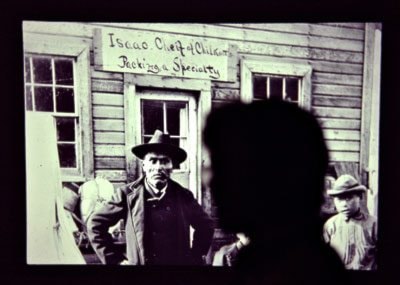Those who rushed to the Klondike in 1897 are often described as hard working, entrepreneurial and tough.
The description also fits those who came to Dawson City to ply their trade in the oldest profession in the world: prostitution.
“When you have thousands of men heading North, you know what follows — women,” said Alice Cyr, who recently gave a talk at the MacBride Museum titled Prospectors and Prostitutes.
These shady ladies were some of Dawson’s most enterprising entrepreneurs when the town population exploded to make it the largest city in Canada west of Winnipeg.
The dance hall girls were there, too, and had considerably more respect than the other ladies of the night.
There were Molly Few Clothes, Oregon Mare, Nellie the Pig, Peahole Annie and of course Diamond Tooth Gertie.
More than 7,000 boats brought men — and a few women — to Dawson at the height of gold fever.
With some claims along the Klondike creeks producing hauls in excess of $100,000 in gold, the newly rich prospectors were too eager to part with their precious metal — many of the hustlers, gamblers and wayward fortune hunters had never been thrifty before, why start now?
And the women who made the treacherous journey to Dawson alongside the men were pleased to help.
Very few men brought their wives and families to the North and the dance hall girls and prostitutes did what they could to make the miners forget about home.
“These were the real hard-working girls,” said Cyr.
“I admire them as much as I admire the prospectors. They endured the same hardships on the trail as the men.”
Which also meant the prostitutes gained respect from most of the miners going through the same trying journey to Dawson.
Enough respect, anyway, that Dawson officials had no problem building infrastructure to assist these ladies of ill repute.
When the Dawson prostitutes became too prevalent for RCMP standards, they were moved across the river to Louse Town in an attempt to curb the sex trade.
“Then the good civic-minded men of Dawson built a bridge across,” said Cyr.
While the good times rolled for the dance hall girls, the prostitutes had quite a different experience.
“They were used, as prostitutes are used today,” said Cyr. “It was the dance hall girls who made the good money. They were freelance and had boyfriends who were the Klondike Kings and saloon owners.”
Many of Dawson’s “daughters of joy” came from Eastern Europe. Most came under the thumb of a pimp — or ‘mack’ as it was known at the time — who closely watched the women.
The mack did not make it easy for the prostitutes to earn money.
“They were more used than getting rich because they were under the thumb of the macks,” said Cyr.
“You can bet your boots he wrung every nickel and dime from those girls to line his pockets.”
Just like in other frontier towns, in Colorado or California, that eventually became more established and stable, trouble began when the men started moving in their families.
“When the wives came, that’s when the friction began,” said Cyr.
Because of the way their clients worked — in the bush for weeks at a time with one set of clothes — the prostitutes weren’t always working with desirable men.
“You’d hope these men in town on a spree would have a bath before coming to see you,” said Cyr.
Prostitution was and is an underground economy, so exact numbers or realistic estimates of how many ladies walked the stroll in Dawson are impossible to come by, but Cyr said it could be near 1,000 if dance hall girls are included.
“They were serving a purpose in a time when these men were mostly young and unencumbered,” said Cyr.
“In a raw frontier setting when these men were in their prime, they were looking for a physical outlet. And some entertainment.”
